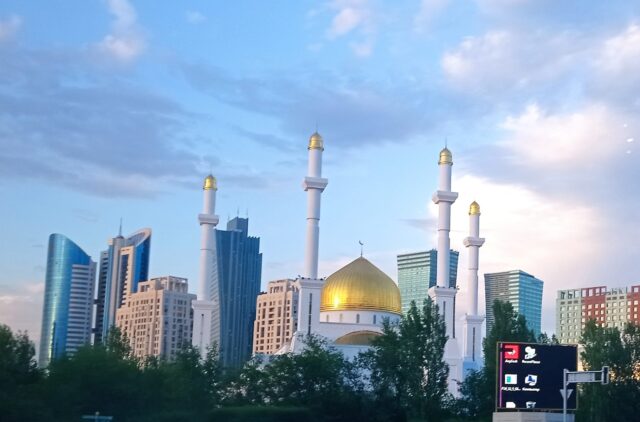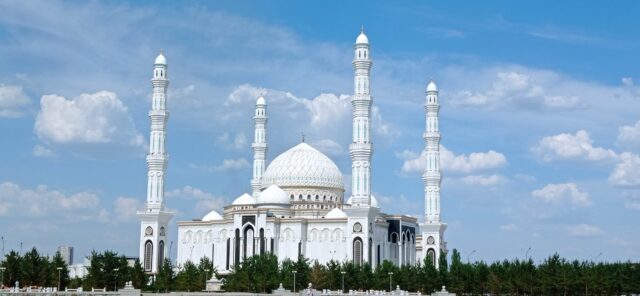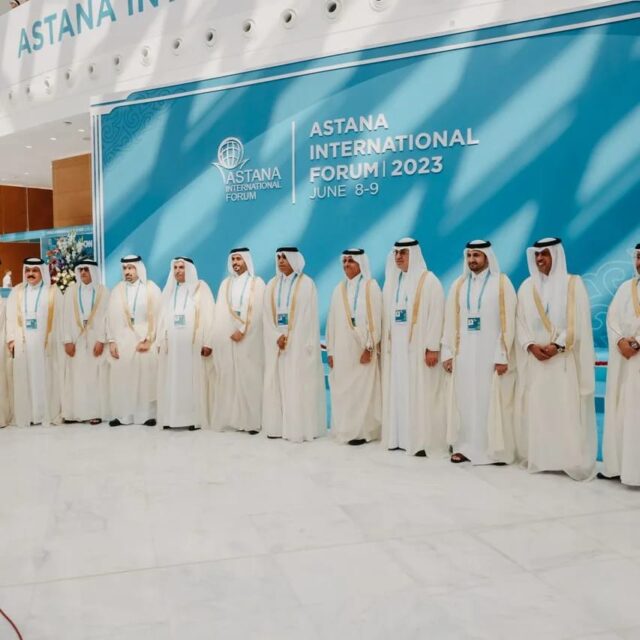Future Prospects Of Kazakhstan: An On-the-Ground Report From Astana

Geopolitical Report ISSN 2785-2598 Volume 32 Issue 6
Authors: Silvia Boltuc
Despite the collapse of the Soviet Union, for most Europeans, Kazakhstan remains an unknown and unexplored land. It has a complex identity halfway between Asia and Europe. A past in the steppes, but with cities such as Astana projected towards the future.
Kazakhstan’s Soviet past is well known; ironically, the country remained the last piece of the Soviet Union for four days when even the area today known as the Russian Federation had left it on December 12th, 1991.
Today, the winds of change are pushing towards a new direction that aims to challenge traditional elements of the past, such as the oligarchic system. 25% of Kazakhstan’s population is from a new generation, not inheriting the Soviet legacy, but making its own demands.
The government addressed these requests through a referendum in June 2022 and the parliamentary elections in March 2023. This event boosted the modernisation and democratisation process, creating the “just and fair Kazakhstan” sponsored by President Kassym-Jomart Tokayev.
The atmosphere in Astana was one of strong expectation regarding a long-awaited change. The referendum led to a constitutional reform which created a new model of Majilis (lower house of Parliament) and maslikhats (local legislative body) to guarantee voters’ national and regional interests and a variety of perspectives in representative power bodies.
The reforms, according to the Government, curbed the President’s authority, bolstered Parliament and human rights, and encouraged citizen involvement in politics.
Kazakhstan’s cultural background
Although the country wants to distance itself from the previous Soviet system, Kazakhstan has not built a narrative of hate on its experience in the U.S.S.R. but bridges. Astana has been able to incorporate Soviet concepts such as the Drúzhba naródov (Дру́жба наро́дов) the “friendship of peoples” in a completely new meaning, freed from its ideological contents.
During the visit in Astana, several times local representatives stressed that the Central Asian Republic today is a country of religious dialogue, as demonstrated by the Congress of Leaders of World and Traditional Religions held in Astana. 17 religious denominations are already represented in the country which has approximately 3.800 religious associations.
Kazakhstan, as always underlined during official meetings, is a secular multi-ethnic state where many ethnic families have been peacefully coexisting for years. Astana tried to mediate as a “Middle Power” in the global arena to strengthen the principals of harmony, tolerance and mutual understanding. In April 2019, by the initiative of the participants of the religious congress, the Nursultan Nazarbayev Center for the Development to Interfaith Inter-civilisational Dialogue was established to popularise the unique Kazakh model of interreligious harmony.
Islam is the largest religion practised in the Central Asian Republic, with estimates of about 70-72% of the country’s population being Muslim. Ethnic Kazakhs are predominantly Sunni Muslims of the Hanafi school, but there are also small numbers of Shias and Ahmadi Muslims.
The presence of Islam in Kazakhstan dates back to the 10th-century Karakhanids, a fiefdom that ruled Central Asia from the 10th to the 13th century. During the Karakhanid dynasty, Islam acquired the status of the state religion.
Since Kazakhstan became independent after the collapse of the Soviet Union, Islam evolved into an influential social force. Over the years, the number of Muslim communities has grown significantly. The culture of Islam in Kazakhstan is one of tolerance.
The presence and importance of religion are immediately apparent to visitors, but not overwhelming. Astana is home to the largest mosque in Central Asia, the Astana Grand Mosque, with minarets in five parts to signify the five pillars of Islam: shahada (profession of Faith), salah (prayer), zakat (almsgiving), sawm (fasting), and hajj (pilgrimage).

Islam is one tool of Kazakh regional policies, even though it should be underlined that it is a more cultural link as the Turkic element. Notably, Kazakhstan shares the membership in some regional and international organisations with a majority of Muslim countries: the Organisation of Islamic Cooperation (OIC), the Organization of Turkic States (OTS) and OPEC +.
Undoubtedly, this cultural element contributed to attract attention from actors such as the Gulf monarchies or Egypt, as proved by the cooperation with the Spiritual Administration of Muslims of Kazakhstan.
The Congress of Leaders of World and Traditional Religions held in Kazakhstan, which brought together representatives of Islam, Christianity, Buddhism, Hinduism, Judaism, and other faiths, shows how Kazakhstan is capable to bridge and mediate among different cultural identities. The state is seen as a “peace hub” due to its mediation activities (for instance the Astana Process over Syria), leading to UNESCO awarding Astana “City of Peace”.
In 1992, President Nursultan Nazarbayev launched a domestic project that reflects the Kazakh attitude to mediation: the Assembly of the People of Kazakhstan. Stalin’s deportations and Khrushchev’s Virgin Lands Program had the side effect of diversifying the country’s ethnic makeup. The Assembly contributes to the creation of favourable conditions for further strengthening of interethnic harmony, and promotes efforts of various ethnic and cultural associations, helps to revive, preserve and develop the culture, language, and traditions of different ethnicities of Kazakhstan.
Of course, there are still open wounds, such as the heavy repercussions of Soviet nuclear tests which led to the contamination of large areas and radiation exposure of the local population; or the collectivisation of semi-nomadic populations ordered by the Communist Party which led to the starvation of almost two million people and the flight of a million from the country.
Nonetheless, the link with Russia has left an important cultural imprint, from the language still widespread today to a wealth of cultural heritage that the Kazakhs have been able to combine with autochthonous and distinctive elements of their steppe heritage. Equally, Kazakh cultural wealth has been partially absorbed by Russia. Traces of this mixture can be found, for example, in the opera.
The first Kazakh Opera, Kyz-Zhibek debuted in 1936 at the first ten-day Festival of the Arts of Kazakhstan in Moscow. It was the first time that operatic arias were sung equally with folk songs. Even today, attending a concert in the sumptuous Astana Opera is a journey between intersecting worlds, with typical elements of Western cultural background accompanied by melodies and instruments typical of Kazakh folklore.
Although the past of the newly formed Republic of Kazakhstan is still vivid in the collective memory, the Central Asian country is certainly looking ahead to the future. With the collapse of the Soviet Union, various international players have been able to grasp the strategic role of Astana in the Eurasian arena: its wealth of raw materials, the various investment and cooperation opportunities in critical sectors yet to be developed, its precious geographical position along the ancient Silk Road.
Kazakhstan’s multi-vector policy
Astana developed a pragmatic foreign policy towards all key states of the global arena, often described as a multi-vector approach.
Among the international partners of New Kazakhstan, alongside the historical bond with Russia that still exists today, there is certainly China. Thanks to its territorial proximity, Beijing has made it the hub of the ambitious Belt and Road Initiative (BRI), becoming one of the key partners in diversifying the Kazakh economy.
Chinese investments span multiple sectors, including oil and gas, transport, digitalization, IT, process industry and green energy. Of particular importance is the activity of the Asian Infrastructure Investment Bank (AIIB). Bilateral trade between the two regional players reached a record of 31 billion dollars in 2022.
Since 2005, the gross inflow of Chinese investments in Kazakhstan has reached 23.2 billion dollars, making China the fourth largest investor in the Kazakh economy. On May 17th, 2023, President Tokayev and Chinese President Xi Jinping held a meeting and reaffirmed their commitment to deepen the eternal all-round strategic partnership.
Walking through the capital, Astana, proceeding from the Syg’anaq ko’piri (Сығанақ көпірі – Gipsy Bridge), the skyline introduces the visitors to another fundamental actor: next to the Moskva Business Center and the Beijing Palace, in fact, there is the tower of the Abu Dhabi Plaza, co-financed by the United Arab Emirates, the tallest building in Central Asia (311 meters). As further demonstrated by the presence of the Emir of Qatar at the Astana International Forum (AIF), the Gulf monarchies are vital partners of Kazakhstan.
For instance, Abu Dhabi has used the leading sovereign wealth fund Mubadala to invest copiously throughout Central Asia, especially in energy and port infrastructure. Mubadala has invested in energy projects in Kazakhstan and the production and distribution of electricity in Uzbekistan.
Furthermore, Dubai-based logistics giant DP World took part in constructing Aktau port in Kazakhstan and the Khorgos-Eastern Gate Special Economic Zone. Recently, on the sideline of the AIF, Masdar has announced it signed a roadmap agreement for developing up to 1 gigawatt (GW) wind power plant in Kazakhstan to support the country’s goal of achieving half its energy mix from renewables by 2050.
Moreover, Etihad Credit Insurance (ECI) and Export Insurance Company (KazakhExport) signed a MoU to enhance trade and support sustainable economic growth between the UAE and Kazakhstan. The UAE, of course, is not the only Gulf country interested in strengthening relations with Kazakhstan.
Saudi Arabia has recently declared that Riyadh will work with Astana on collaborating in the fields of petroleum, gas, refining, petrochemicals and electricity. As for Qatar, on the sidelines of the third Qatar Economic Forum in May 2023, Kazakh Prime Minister Alikhan Smailov outlined that in the first quarter of this year, bilateral trade between Astana and Doha increased by 17.7 times. Notably, in 2022, Qatari investments in the Kazakh economy have tripled.
The rising Gulf-Asia cooperation is testified by the Gulf countries’ interest in the Eurasian Economic Union (EAEU) and the Shanghai Cooperation Organisation (SCO). Having Kazakhstan full membership in both of the two regional organisations, Astana might benefit of policies such as free trade agreements with Gulf countries and establish itself as a transit hub, not only for goods going from China to Europe, but also from Russia towards the Middle East and India.

The Middle Corridor is an important part of the region’s infrastructure. The Middle Corridor, or Trans-Caspian International Transport Route (TITR), indeed, might become a direct competitor of the Northern Corridor running through Russia.
Trade between China and Europe is valued at 600 billion dollars a year. This corridor will run through Central Asia, the Caspian Sea and the South Caucasus reducing massively the connection from Est to West. There are still limitations in terms of soft and hard infrastructures which need to be addressed. The corridor attracted several investments, becoming a promising Eurasian route.
European Bank for Reconstruction and Development (EBRD) states that given targeted investments amounting to 18.5 billion euros, the route could reach a capacity of 1.4 million TEU by 2040. Most of the critical investments focus on Kazakhstan and include substantial railway upgrades, focusing particularly on green and digital transitions.
Besides cooperating over the Middle Corridor, during COP27 in Egypt, in November 2022, the EU and Kazakhstan signed a MoU on a strategic partnership in raw materials, batteries and renewable hydrogen which will boost transition to carbon neutrality by 2060. The EU has invested 160 billion dollars in Kazakhstan, making it the largest investment and trading partner. In 2020, the European Union-Kazakhstan Enhanced Partnership and Cooperation Agreement (EPCA) entered force.
Kazakhstan has not only the potential to connect China with Europe through the Middle Corridor but it is also part of the link running from Russia to India via Iran: the International North-South Trasport Corridor (INSTC).
The INSTC connects the Nordic countries and the North-Western part of the EAEU to the Gulf and Indian Ocean states via the Caucasus and Central Asia, helping Indian goods reach central Asia bypassing Pakistan.
Kazakhstan, which joined the INSTC agreement in 2003, has become more and more attractive for India, which through the corridor can exploit Iranian ports to deliver its goods in landlocked countries. A stable transport connection has been established between the ports of Aktau and the northern ports of Iran, Anzali, and Amirabad.
The Aktau seaport is becoming one of the leading Kazakh assets, as it is also the main Central Asian maritime connection of the Middle Corridor. The project known as Sarzha will reportedly improve the port capacity by more than 500 percent by 2025 and a Special Economic Zone was established to attract investments. Allegedly also the Kuryk Port will be developed.
In addition to the previous players, the United States also wants to strengthen and increase bilateral relations with Kazakhstan since the country’s geostrategic position in Central Asia. In November 2022, the U.S. Ambassador to Kazakhstan, Daniel Rosenblum, during a meeting with Kazakh journalists at the U.S. Embassy, stressed that U.S. companies were exploring “reliable new ways to export Kazakh oil”.
The United States strongly supports President Tokayev’s reform agenda. Following the collapse of the Soviet Union, Washington was the first to recognise Kazakhstan’s independence. U.S.-Kazakh cooperation in security and nuclear non-proliferation is a cornerstone of the relationship which further concerns security, trade and investments.
The U.S. firms have invested tens of billions of dollars in Kazakhstan, concentrated in the oil and gas sector and both countries are part of international organisations such as the United Nations or the Euro-Atlantic Partnership Council.
Conclusion
In January 2022, Kazakhstan faced internal protests, which the government overcame thanks to the military support of the Collective Security Treaty Organisation (CSTO). After January, the government held a Referendum for constitutional reform and the presidential elections that confirmed Kassym-Jomart Tokayev’s leadership for the next seven years.
The parliamentary election of March 2023 was the ultimate step to consolidate the shift of the country towards the New Kazakhstan. With the major threat represented by the internal protests left behind, Kazakhstan is focusing now on the future.
On the economic front the government addressed corruption, monopolies, an overbearing presence of the state in economy and critical aspects such as low productivity and lack of capital market development. Global and regional financial integration is supported by the International Financial Centres (IFCs), which works for ensure a competitive private sector.
Given its geopolitical location, Kazakhstan chose to pursue a multi-vector foreign policy to protect national interests. The Ukraine conflict has posed Kazakhstan in front of a difficult challenge. The war of sanctions has impacted the state’s economy and had the potential of causing a global recession, particularly in the aftermath of the Covid pandemic, which could affect business confidence in the region. Astana pursued a balanced foreign policy between the West, Russia, and China, while respecting international laws and sanctions.
The tragic events that occurred in Kazakhstan in January 2022 pushed the government to transform the political and socio-economic landscape of the country. The creation of a ‘just and fair Kazakhstan’ through the Referendum and elections boosted the democratisation process inside the country. While format as the Astana Peace negotiation or the Congress of Leaders of World and Traditional Religions showed the Central Asian Republic precious role as a mediator, the recent AIF demonstrate Astana willingness to create platforms for dialogue to tackle future challenges in the field of security, sustainability, climate change, energy and economy.
Since the collapse of the Soviet Union global and regional powers have fought to influence this energy and natural resources-rich country. The United States and the EU are increasing their presence in the country because of economic interests and attempting to diminish the Russian influence and the Chinese economic presence in Kazakhstan. Despite the pressure, Kazakhstan chose to trade and cooperate with all interested actors: Turkey, Iran, Russia, China, the U.S., Europe, the Caucasus and Gulf countries. As a strategic Middle Power, Kazakhstan has the potential to mediate and influence international dynamics positively.
Notably, being the Republic a landlocked country, it entered the main regional corridors, such as the Trans-Caspian and the INSTC. In the future, for Astana it would be fundamental to attract investments and develop its connectivity infrastructures.
Do you like SpecialEurasia reports and analyses? Have our groundbreaking research empowered you or your team? Now is your chance to be a part of our mission! Join us in advancing independent reporting and unlocking the secrets of Eurasia’s complex geopolitical landscape. Whether through a one-time contribution or a monthly/yearly donation, your support will fuel our relentless pursuit of knowledge and understanding. Together, let’s pave the way for a brighter future. DONATE NOW and secure your place in shaping the geopolitical narrative.
